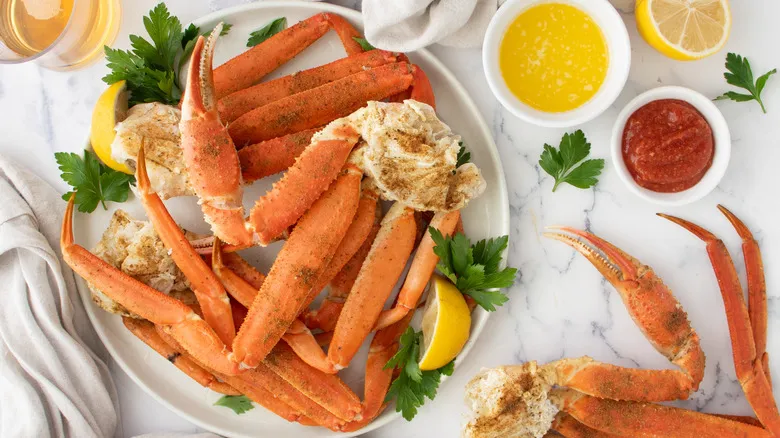Intro to crab legs
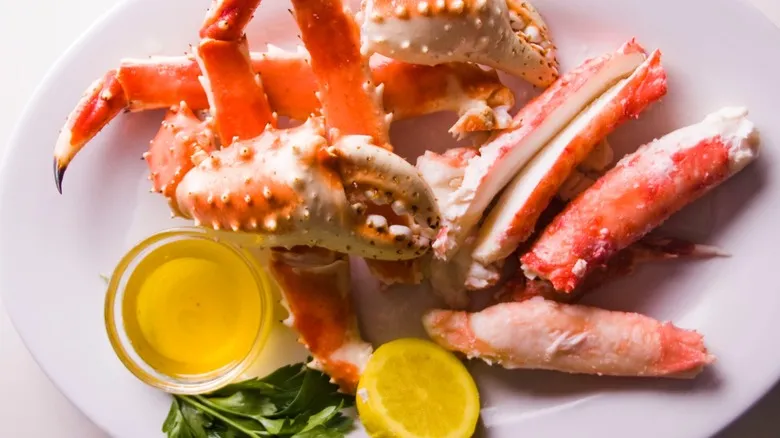
There are more than 6,000 varieties of crabs swimming or scuttling across our vast and stunning planet. From this extensive array, only a select few crab species find their way to our dinner tables. The most sought-after, and also the largest and most leggy, include the Dungeness crab, snow crab, and king crab. Before diving into the details of these beloved crustaceans, let's tackle the most common question: How many crab legs should you purchase?
A good guideline for planning a crab leg feast is to estimate about 1½ to 2 pounds of crab legs per adult. If you're expecting a group of hungry crab enthusiasts, it's wise to lean towards the 2-pound mark, or even more if your guests are particularly famished. If you're serving side dishes alongside the crab legs, aim for the 1½ pound range. Typically, most crab legs or clusters weigh around 1 pound each.
Dungeness crab legs
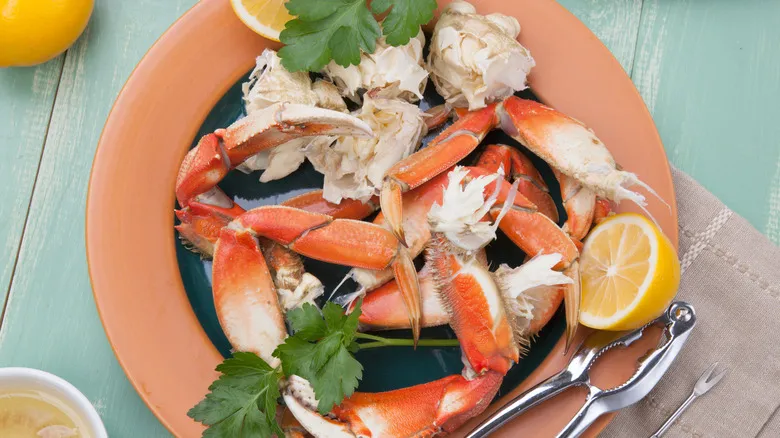
Dungeness crabs are a culinary treasure of the West Coast, inhabiting the cool Pacific waters along the shores of Washington, Oregon, and Northern California (the name Dungeness comes from a fishing area in Washington State). The Dungeness crab season spans from early December to June, with a short lull during the coldest winter months. If you’re not located in the Pacific Northwest, there’s no need to worry—numerous seafood companies deliver frozen Dungeness crab legs across the United States, making it relatively simple to find them at your local grocery store or through online retailers.
In terms of flavor and texture, the meat of Dungeness crab legs is firm and reminiscent of lobster, boasting a rich sweetness that some describe as slightly nutty. While they may not be the largest among crabs, their legs are substantial and often sold in hearty clusters that include both legs and portions of the body. They are also the mid-range option in terms of price, typically costing between $20 and $45 per pound.
Snow crab legs
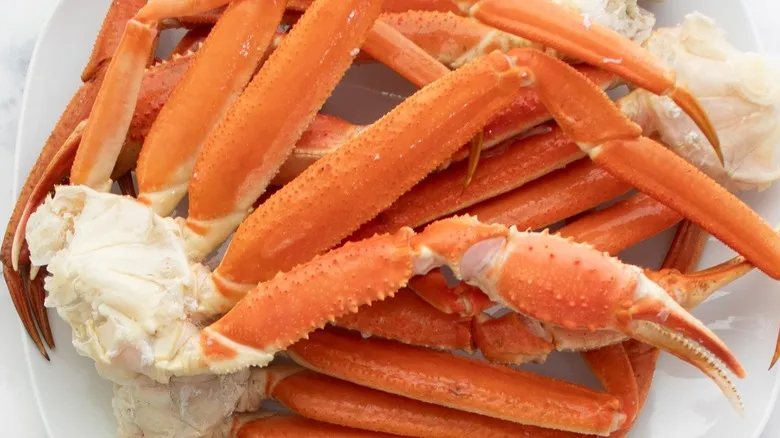
Snow crabs are the most widely distributed crabs, inhabiting the frigid waters of both the North Pacific and North Atlantic. The snow crab season kicks off only when the ice melts, typically from mid-April to early November. Due to their extensive range, snow crabs are among the easiest to find in the United States, readily available at most grocery stores nearly year-round.
The name "snow" refers to the nearly snow-white color of the cooked meat. The meat itself is firm and fibrous, offering a savory, briny taste with hints of sweetness. While snow crabs may not be as meaty as their king and Dungeness relatives, they still provide a satisfying and hearty option for gatherings. They are sold in clusters that include claws, legs, and a small portion of the body (which is primarily legs, as their actual bodies measure only 4-6 inches in width). Additionally, snow crabs are the most budget-friendly option among crab legs, with prices ranging from $9 to $30 per pound.
King crab legs
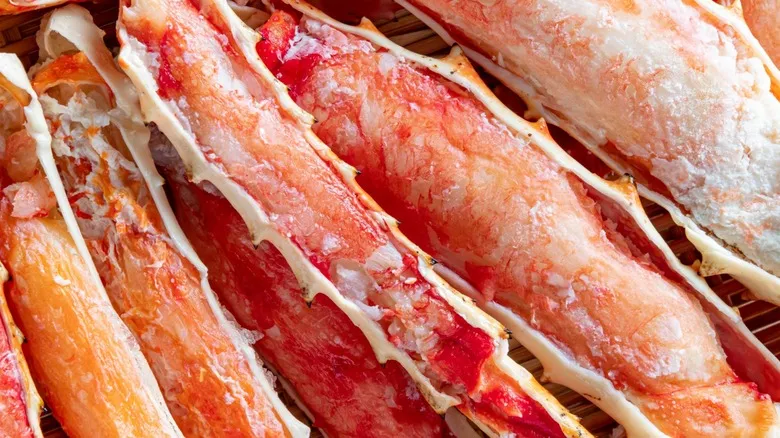
These Alaskan crabs have truly earned their reputation. King crabs are incredibly large! Whole crabs typically weigh between 6 to 8 pounds, with records showing that they can exceed 20 pounds, and their leg span can reach between 3 to 6 feet. Each leg can weigh as much as 2 pounds on its own. These crabs are certainly impressive.
They are harvested during the early winter months, mainly from October to January. It takes king crabs approximately 7 to 9 years to grow to the legal size for harvesting. Biologists monitor the population to ensure it remains sustainable for both recreational and commercial crabbing, often pausing or canceling the harvest season to allow for growth, which can affect their availability in grocery stores and online markets. King crabs have a firm, delectable texture and a remarkable sweet, succulent, and buttery flavor. As expected, they are the priciest crab legs available, with prices ranging from $50 to $100 per pound. However, you might get lucky—Costco has been known to offer wild-caught king crab legs for $43.99 per pound.
Tools you will need
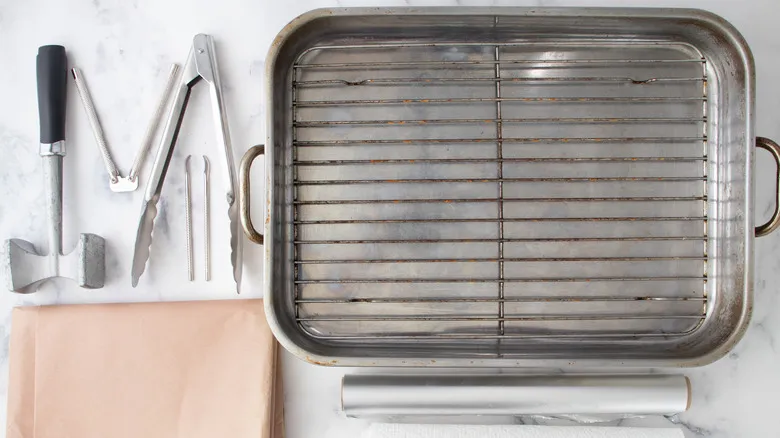
Now that we've narrowed down our options for crab legs, it's time to start cooking! To achieve perfectly steamed crab legs using the roasting pan method, we will need a roasting pan, of course. We recommend a larger roasting pan, measuring between 16 to 18 inches (which can accommodate a turkey weighing over 20 pounds), to comfortably hold 4 to 8 pounds of crab legs. A roasting pan allows for an even and spacious steaming environment for the crab legs. In contrast, steamer pots or other tools that stack food can trap steam at the bottom, resulting in uneven cooking or overcooking.
If your roasting pan has a high lid, that's ideal. If not, a couple of sheets of aluminum foil will suffice. You'll also need a flat rack insert to keep the crab legs elevated above the liquid, along with a pair of tongs for easy removal once they are steamed.
For serving, we suggest having nutcrackers, crab pickers, and a mallet on hand to tackle those tough shells. To keep your crab leg feast organized, line your dining table with newspaper, butcher paper, or parchment, and make sure to have plenty of paper towels or napkins available (and perhaps a bib or two for those who really want to dig in).
Ingredients you will need
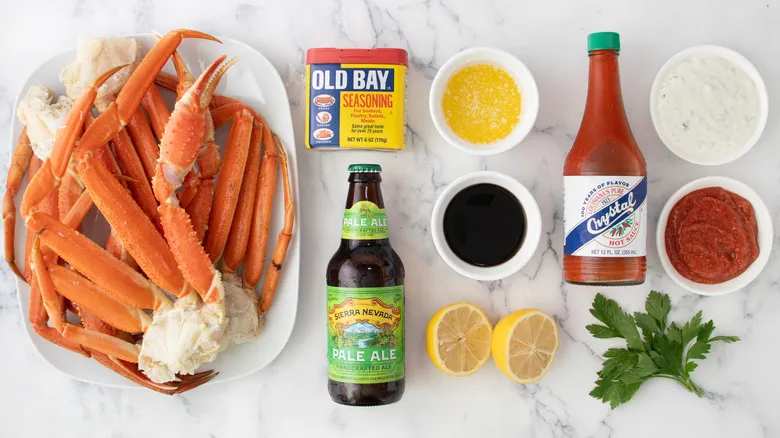
When it comes to the ingredients, we prefer to keep it straightforward, allowing the natural taste of the crab to shine. Along with your crab legs, you'll need 12 to 16 ounces of beer and either Old Bay or seafood seasoning. If you enjoy creating your own spice blends and have a well-stocked spice cabinet, consider crafting your own homemade Old Bay seasoning.
To complement your steamed crab legs, we suggest serving melted butter, malt vinegar, hot sauce, lemon, cocktail sauce, and tartar sauce for dipping. You can also add a touch of fresh parsley as a garnish for an attractive presentation. For the melted butter, opting for a high-quality salted butter is always a wise choice. If you want to elevate the flavor, you can create your own buttery dipping sauce. Malt vinegar is a matter of personal taste for many crab enthusiasts, providing a delightful balance of sweetness and acidity. Choose a relatively mild hot sauce—nothing too extreme unless you enjoy a serious kick. A bit of heat works well with citrus, butter, and seafood seasoning. As for the cocktail and tartar sauces, you can either make them from scratch or buy your favorite pre-made versions—there are no wrong choices here!
Why use beer?

Absolutely, beer! It serves as an amazing flavor enhancer, adding unexpected aromas, even if our crab legs won’t directly touch it. When you generate steam, tiny molecules from the liquid are released into the air. These molecules dance around inside your sealed steamer, gently infusing your food with flavor. The type of beer you choose can introduce delightful and subtle notes to your crab legs. For example, a lighter beer can add hints of malty sweetness, complementing the natural sweetness of the crab meat. Pale ales and IPAs can contribute the unique characteristics of their hops, such as citrus, herbs, pine, or tropical flavors. Wheat beers are also known for their citrusy profiles, which can enhance your crab legs as well.
If you prefer a non-alcoholic option, you can use non-alcoholic beer or even non-alcoholic wine. We’ve even experimented with a mix of unsweetened lemonade and tea, Arnold Palmer-style, and achieved surprisingly delicious results. Broths infused with citrus and fresh herbs are great alternatives too. Once you’ve chosen your liquid, we’re all set to start cooking!
Fill the pan and preheat
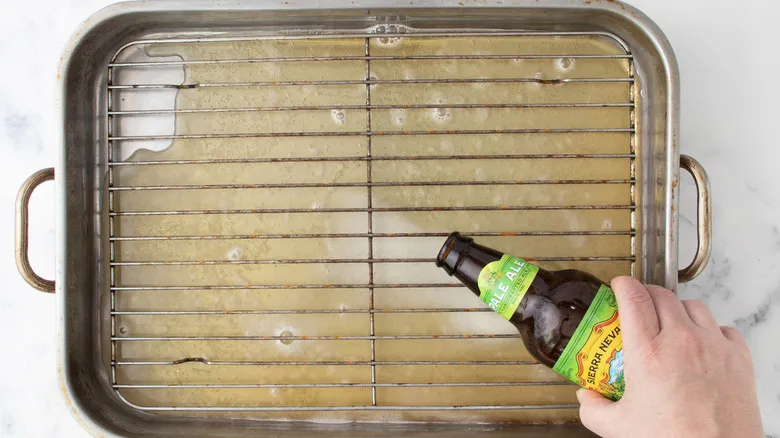
The wonderful aspect of this roasting pan technique is its versatility; it can be utilized in both the oven and on the stovetop. The stovetop approach is significantly quicker, allowing you to steam your crab legs in under 30 minutes, while the oven method offers a slower, more leisurely process—ideal for those who enjoy entertaining guests without being confined to the kitchen.
To start, position the flat rack at the bottom of your roasting pan. Pour beer into the pan, ensuring it doesn’t overflow the rack. Then, cover the pan with either the lid or aluminum foil.
For the stovetop method, set the covered pan on the larger burner, and bring the beer to a gentle simmer over medium-low heat, which should take about 5 minutes until it starts steaming. For the oven method, place the covered pan in a preheated oven at 350°F and heat for 15-20 minutes, or until you see steam.
Add the crab legs and seasoning
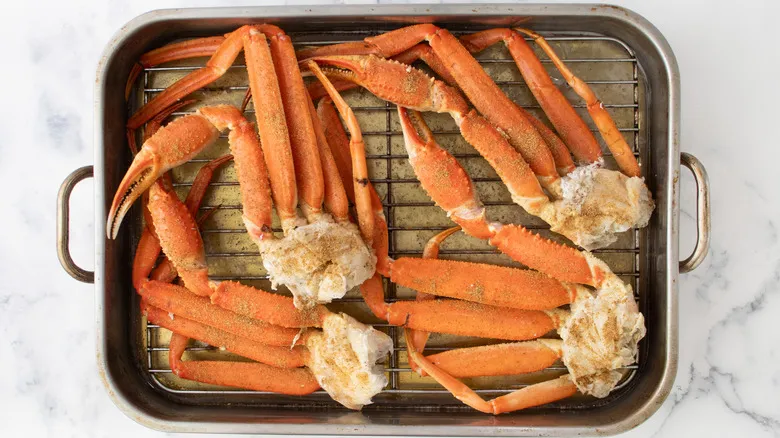
Once your beer is bubbling, take the pan off the heat (whether from the stove or oven) and carefully lift off the lid or foil (using tongs can help with the foil). Arrange the crab legs on the rack. If you need to stack them, make sure there’s enough space for the steam to circulate evenly. Sprinkle the legs or clusters with seafood seasoning, using about ½ teaspoon of seasoning for each cluster. Cover the pan with the lid or aluminum foil and return it to the heat source (oven or stovetop).
For stovetop steaming, thawed crab legs will be perfectly cooked in 15 to 20 minutes. For oven steaming, they will take about 25 to 30 minutes. If your crab legs are still slightly frozen, add an extra 5 to 10 minutes to the cooking time; if they are completely frozen, thaw them in the refrigerator for 1 hour before cooking.
Putting it all together
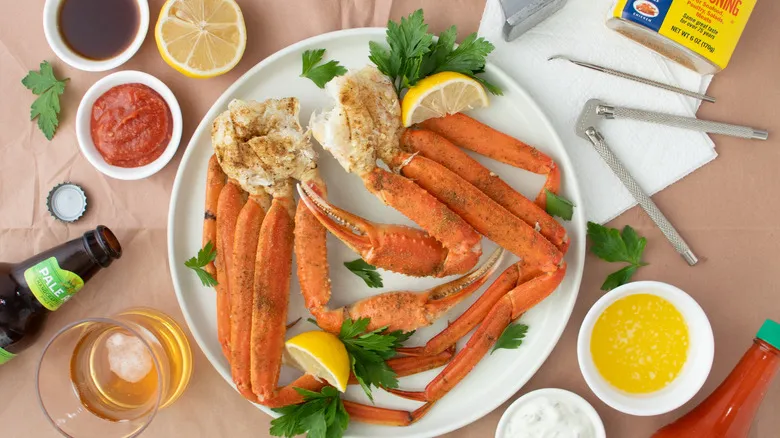
Before you start steaming your crab legs, or even while they’re cooking, ensure your dining table is properly prepared. Lay down some newspaper, butcher paper, or parchment to protect the surface. If you're concerned about crab juices damaging your table, you can place a plastic tablecloth underneath the paper. Keep plenty of cleaning supplies nearby, such as paper towels, napkins, or moist towelettes. For tougher crab legs like king and Dungeness, you’ll definitely need a mallet or two to crack those hard shells, along with nutcrackers and crab picks. Snow crab legs, on the other hand, have softer shells, so a mallet is usually unnecessary.
Be sure to have a variety of dipping sauces ready. Melted butter is a favorite, but you can also offer cocktail sauce, hot sauce, malt vinegar, and tartar sauce. Lemon wedges or slices are perfect for adding a zesty kick. You can present your dipping sauces in individual bowls for larger gatherings or in larger containers for smaller ones.
Once your table is ready, serve the perfectly steamed crab legs on a large platter, portion them onto individual plates, or place them directly on the prepared table. It’s also a good idea to have a bowl (or several) for shell disposal to make cleanup easier. Now, dig in and enjoy!
Recommended
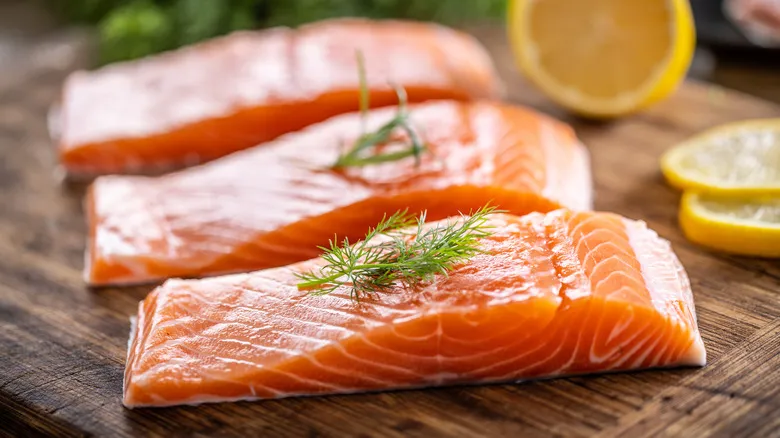
11 Genius Ways To Disguise Fishy Tastes In Seafood

How To Cook Delicata Squash Like A Pro

How To Easily Turn A Stainless Steel Skillet Into Nonstick Pan

The Best Way To Serve Hot Chocolate To A Crowd Is Too Easy
Next up

